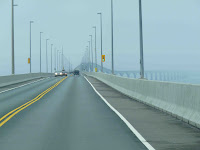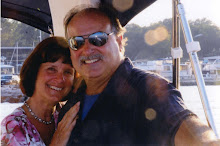
The island itself has beautiful landscapes and beautiful flowers, lupines.
We began our tour at PEI National Park. Their beaches are different than what we’re used to. They called the sand at this beach “white sand” while on the other side of the island, it is red. But, looked like red sand to me…. I can only assume the sand on the other side, must be “really” red.

While visiting North Rustico, we met 87 year old Emerad (not sure of the spelling of his name), the only Protestant family in this area. Everyone else is Roman Catholic. What a character he is. He loves to get his picture taken and was more than willing to pose for us.

What a ham! He was born in 1923 and lived in his house next to the lighthouse all his life. He talked about people from all over the world coming to take his picture. One lady from Ohio won a blue ribbon for his photo and other couple from Germany showed him an advertisement in their newspaper of his house. He is world famous!
A whale’s jawbone washed up on shore about 80 years ago, so Emerad’s family uses it as the border for their garden. Can you tell it’s a jawbone?
While visiting the harbor, hoping to see a lobster catch come in, we spotted a tow truck for those boats that sometimes need help. We liked his slogan, “No Cash, No Splash.”
Lunch was at the PEI Preserve Company, where we met the owner, Bruce. What a character he is! He’s Scottish and always had a dream of owning his own restaurant. After practically losing his shirt, he came up with a preserve with alcohol incorporated into the recipe, TOTALLY BY ACCIDENT. It seemed while working for someone else, who liked to drink, Bruce decided to help his boss drink the Grand Marnier (he was saving him from getting toooooo intoxicated). When Bruce could drink no more, he had no alternative but to dump the rest of the bottle into the vat of preserves. VOILA! Strawberry preserves with Grand Marnier. Once he had a product, he needed a label. The girl he was dating was a good artist, so she designed him a label. He since married her, they bought and old butter factory, started a restaurant, and that is how the PEI Preserve Company started. Check out the quilts hanging on the ceiling.

In the 19 years he’s been in business, he’s become famous for his preserves all over the world, even selling to Nordstrom’s and Neiman Marcus! My favorite is the Raspberry with champagne jam and Peach Salsa. Bill’s favorite is the strawberry with Grand Marnier jam.
Next, it was off to visit the house that inspired the book “Anne of Green Gables.” Anne’s room is just as the book describes.

The author, Lucy Maud Montgomery, was born in New London, Prince Edward Island, in 1874 and was raised by her maternal grandparents (Alexander and Lucy Macneill) in Cavendish 1976-1911. It was here that she wrote Anne of Green Gables, Anne of Avonlea, Kilmeny of the Orchard and The Story Girl.
I was very surprised to find out is that Anne is fictional. I always thought she was a real person. Montgomery found inspiration in glossy magazines and used a photograph of New York model Evelyn Nesbit as the origin for Anne’s face. It was amazing to find all the things that inspired her to write her book. Her adopted cousin, Ellen Macneill, a Nova Scotia orphan girl, provided the final spark for the inspired story of the redheaded orphan.
Haunted Wood Trail

The Balsam Hollow trail begins as Montgomery’s own Lover’s Lane.

In 1831, the farm Montgomery named “Green Gables” was acquired by David Macneill Sr. When he died in 1891 the farm passed on to his son, David, Jr., who lived there with his sister Margaret. In the early 1890s their niece Ada Macneill and her daughter Myrtle came to live with them. In 1906, Myrtle and her husband Ernest Webb took over the farm.
While driving around we found L.M. Montgomery’s birthplace

As well as her resting place.

We also found the site of her Cavendish home. John Macneill is the great-grandson of Alexander, was born and still lives in his grandfather’s house.
While in North Rustico, we bought our own fresh lobster from the wharf. Our first of many lobster dinners was simply delicious!
On our free day, we visited the town of Summerside.

Throughout the town are beautiful murals.

In the park, located in the center of town, we found a few trees that were shaped into artwork. It shows their creativity for trees that were in need of being chopped down.

The Haunted Mansion looked interesting.

We had a great lobster dinner at the Fisherman’s Wharf, complete with a HUGE salad/dessert buffet. While waiting for our soup and lobster, I began my dinner with dessert! I could not decide which dessert to eat, so I had several. After our dinner, the manager invited us to tour the kitchen. They serve between 450 and 500 lobsters per night!
Check out the 3 ½ pounder.
On our drive back to the campground, we came upon a red fox. Bill stopped so I could get a picture. The fox stopped and watched me for as long as I watched him. See how nice he posed for me?
Our campground hosts were wonderful saving us “adult” time on the “balloon jump.”
Our last day in PEI was rain, rain, rain. So this was a catch up day while waiting for our driver’s meeting and bus to take us into Charlottetown for dinner. Check out the rat Bill found just outside the theater.
What a fabulous play. I didn’t realize he was only 21 or 22 when he was killed in a plane crash. He put out 10 top songs in 18 months. Just imagine what would have happened had he not been killed.
















































